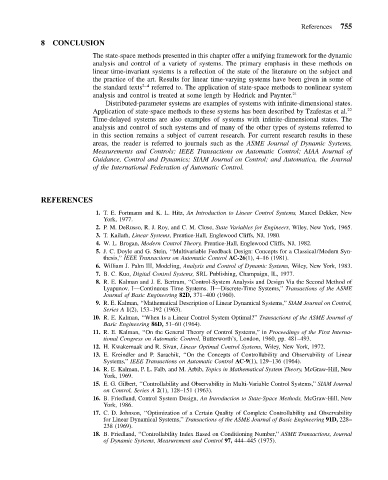Page 764 - Mechanical Engineers' Handbook (Volume 2)
P. 764
References 755
8 CONCLUSION
The state-space methods presented in this chapter offer a unifying framework for the dynamic
analysis and control of a variety of systems. The primary emphasis in these methods on
linear time-invariant systems is a reflection of the state of the literature on the subject and
the practice of the art. Results for linear time-varying systems have been given in some of
the standard texts 2–4 referred to. The application of state-space methods to nonlinear system
analysis and control is treated at some length by Hedrick and Paynter. 21
Distributed-parameter systems are examples of systems with infinite-dimensional states.
Application of state-space methods to these systems has been described by Tzafestas et al. 22
Time-delayed systems are also examples of systems with infinite-dimensional states. The
analysis and control of such systems and of many of the other types of systems referred to
in this section remains a subject of current research. For current research results in these
areas, the reader is referred to journals such as the ASME Journal of Dynamic Systems,
Measurements and Controls; IEEE Transactions on Automatic Control; AIAA Journal of
Guidance, Control and Dynamics; SIAM Journal on Control; and Automatica, the Journal
of the International Federation of Automatic Control.
REFERENCES
1. T. E. Fortmann and K. L. Hitz, An Introduction to Linear Control Systems, Marcel Dekker, New
York, 1977.
2. P. M. DeRusso, R. J. Roy, and C. M. Close, State Variables for Engineers, Wiley, New York, 1965.
3. T. Kailath, Linear Systems, Prentice-Hall, Englewood Cliffs, NJ, 1980.
4. W. L. Brogan, Modern Control Theory, Prentice-Hall, Englewood Cliffs, NJ, 1982.
5. J. C. Doyle and G. Stein, ‘‘Multivariable Feedback Design: Concepts for a Classical/Modern Syn-
thesis,’’ IEEE Transactions on Automatic Control AC-26(1), 4–16 (1981).
6. William J. Palm III, Modeling, Analysis and Control of Dynamic Systems, Wiley, New York, 1983.
7. B. C. Kuo, Digital Control Systems, SRL Publishing, Champaign, IL, 1977.
8. R. E. Kalman and J. E. Bertram, ‘‘Control-System Analysis and Design Via the Second Method of
Lyapunov. I—Continuous Time Systems. II—Discrete-Time Systems,’’ Transactions of the ASME
Journal of Basic Engineering 82D, 371–400 (1960).
9. R. E. Kalman, ‘‘Mathematical Description of Linear Dynamical Systems,’’ SIAM Journal on Control,
Series A 1(2), 153–192 (1963).
10. R. E. Kalman, ‘‘When Is a Linear Control System Optimal?’’ Transactions of the ASME Journal of
Basic Engineering 86D, 51–60 (1964).
11. R. E. Kalman, ‘‘On the General Theory of Control Systems,’’ in Proceedings of the First Interna-
tional Congress on Automatic Control, Butterworth’s, London, 1960, pp. 481–493.
12. H. Kwakernaak and R. Sivan, Linear Optimal Control Systems, Wiley, New York, 1972.
13. E. Kreindler and P. Sarachik, ‘‘On the Concepts of Controllability and Observability of Linear
Systems,’’ IEEE Transactions on Automatic Control AC-9(1), 129–136 (1964).
14. R. E. Kalman, P. L. Falb, and M. Arbib, Topics in Mathematical System Theory, McGraw-Hill, New
York, 1969.
15. E. G. Gilbert, ‘‘Controllability and Observability in Multi-Variable Control Systems,’’ SIAM Journal
on Control, Series A 2(1), 128–151 (1963).
16. B. Friedland, Control System Design, An Introduction to State-Space Methods, McGraw-Hill, New
York, 1986.
17. C. D. Johnson, ‘‘Optimization of a Certain Quality of Complete Controllability and Observability
for Linear Dynamical Systems,’’ Transactions of the ASME Journal of Basic Engineering 91D, 228–
238 (1969).
18. B. Friedland, ‘‘Controllability Index Based on Conditioning Number,’’ ASME Transactions, Journal
of Dynamic Systems, Measurement and Control 97, 444–445 (1975).

